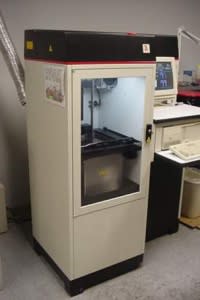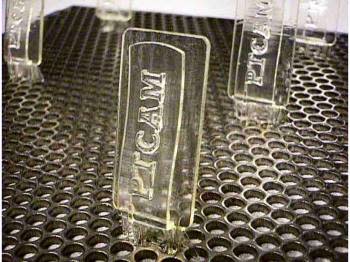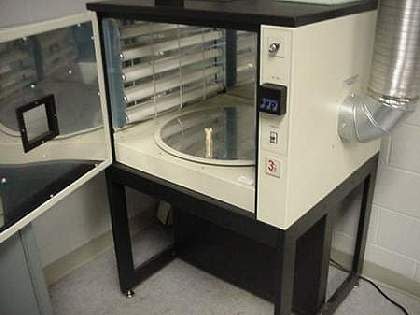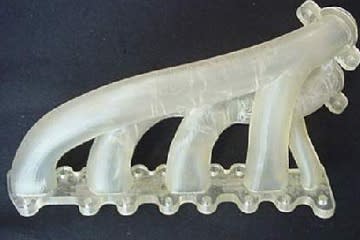How Stereolithography Works: A 3D Printing Process

Stereolithography, also known as 3D layering or 3D printing, allows you to create solid, plastic, three-dimensional (3D) objects from computer-aided design (CAD) drawings in a matter of hours.
Whether you are a mechanical engineer wanting to verify the fit of a part or an inventor looking to create a plastic prototype of an invention, stereolithography gives you a fast, easy way to turn CAD drawings into real objects.
3D printing is an excellent example of the age in which we live. In the past, it could conceivably take months to prototype a part; today, rapid prototyping can take place over mere hours, and with astoundingly functional mechanical properties.
Read on as we take a tour of the stereolithography service bureau at PT CAM (Piedmont Triad Center for Advanced Manufacturing) so that you can understand everything involved and see some actual 3D models that this technology can produce.

The Stereolithography Machine
PT CAM uses a stereolithography machine produced by 3D Systems. This machine has four important parts:
A tank that contains several gallons of liquid photopolymer. The photopolymer is a clear, liquid plastic.
A perforated platform immersed in the tank. The platform can move up and down in the tank as the printing process proceeds.
A UV laser. Some SLA printers use a digital light processing technology as a UV light source.
A computer that drives the laser and the platform
The photopolymer is sensitive to ultraviolet light, so when the laser touches the photopolymer, the polymer hardens. If you stand next to the stereolithograph apparatus (SLA), you can actually see the laser as it builds each layer.
SLA Materials
A few primary materials include photosensitive polymers and support structures, which support overhanging features but do not pass the post-processing. Secondary and specialized materials are high heat deflection and high-temperature resins, both of which can withstand high heat deflection temperatures, and flexible and durable resins fit for bending and flexing.

The Stereolithography Process
The core of SLA printing involves a laser beam precisely directed by a light-emitting device to cure the polymer resin in a resin tank. The SLA printing process goes something like this:
You create a 3D model of your object in a CAD program.
A piece of software chops your CAD model up into thin layers — typically five to 10 layers per millimeter.
The 3D printer's laser "paints" one of the layers, exposing the liquid plastic in the tank and hardening it.
The platform drops down into the tank a fraction of a millimeter and the ultraviolet laser paints the next layer of uncured resin to cover the previous layer.
This process repeats, layer by layer, until your model is complete.
This is not a particularly quick process. Depending on the size and number of objects being created, the laser might take a minute or two for each layer. A typical run might take 6 to 12 hours. Runs over several days are possible for large objects (maximum size for the relatively old machine shown above is an object 10 inches, or 25 centimeters, in three dimensions).
You start by creating a 3D design for your object in a CAD program. This design is tweaked before building with supports that raise it up off the tray slightly and with any internal bracing that is required during building. The SLA then renders the object automatically (and unattended).
When the process is complete, the SLA raises the platform and you end up with your 3D object. If the object is small, you can produce several of them simultaneously if you like. They all sit next to each other on the tray.
The following photo shows a tray after building is complete, with several identical objects produced simultaneously:

Once the run is complete, you rinse the objects with a solvent and then "bake" them in an ultraviolet oven that thoroughly cures the plastic.

Advantages of Using SLA Technology
SLA technology offers several benefits over traditional manufacturing methods like injection molding and fused deposition modeling. It is capable of producing parts with smooth surface finishes, fine features, and high complexity without the need for multiple tools or molds.

What You Can Create with Stereolithography
Stereolithography allows you to create almost any 3D shape you can imagine. If you can get it into a CAD program, you can probably create it. The only caveat is the need for structural integrity during the building process. In some cases, you need to add internal bracing to a design so that it does not collapse during the printing or curing phases.
The photo on this page shows you a typical object that was created at PT CAM. The piece is lightweight and has the strength of polystyrene plastic. Since you can mount and drill pieces, you can try it out in actual use.
For example, a chair manufacturer will produce different armrest shapes using stereolithography and try them out on actual chairs to see how they feel.
Costs of Stereolithography
Stereolithography is not an inexpensive process. The machines once cost in excess of $250,000 and still get up to tens of thousands of dollars (but you can find desktop SLA printers for much less). You also need to vent them because of the fumes the polymer and the solvents create.
The polymer is extremely expensive as well. CibaTool SL5170 resin, a common photopolymer used in stereolithography, cost about $800/gallon when we visited PT CAM. For these reasons, it is uncommon to find professional stereolithography machines anywhere but in large companies.
However, there are service bureaus that can make the advantages of stereolithography available to smaller shops and individuals. It's still not cheap, but compared to purchasing your own SLA and resin or having parts machined, it is a real bargain.
Special thanks to Joel Leonard, Jerry Watkins and Steve Oneyear for their help in creating this article!
We updated this article in conjunction with AI technology, then made sure it was fact-checked and edited by a HowStuffWorks editor.
Lots More Information
Related Articles
3-D Printing Quiz
More Great Links
3-D Systems - maker of stereolithography equipment
Original article: How Stereolithography Works: A 3D Printing Process
Copyright © 2024 HowStuffWorks, a division of InfoSpace Holdings, LLC, a System1 Company

